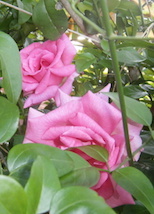Jodo Wasan 68
It is difficult to encounter a time when a Tathagata appears
in the world,
And difficult to hear the teaching of the Buddhas;
It is rare to hear the excellent dharma for bodhisattvas,
Even in a span of countless kalpas.
The Bodhisattva Vehicle
The four vehicles are: first, the Buddha vehicle; second, the bodhisattva vehicle; third, the pratyekabuddha vehicle; fourth the shravaka vehicle. The Pure Land school belongs to the bodhisattva vehicle.
The two collections of scripture are: first, the bodhisattva pitaka; second, the shravaka pitaka. The present teaching belongs to the bodhisattava pitaka.1
In his otherwise excellent introduction to Buddhism2 Hans Wolfgang Schumann offers the view that the Mahayana provides several distinct paths to liberation. Among them are the bodhisattva way and the way of 'faith'. He includes Jodo Shinshu in the group he describes as the 'way of faith'. Generally speaking, however, almost all Mahayana schools are considered to be part of the bodhisattva vehicle (Sk. bodhisattvayana). It is not really correct to suggest a seperate classification within the Mahayana of a special school described as 'the way of faith'. In fact, when Schumann outlines the bodhisattva vehicle he is unwittingly writing a summary of Jodo Shinshu. This is not to criticize Schumann because he is a Sanskrit scholar and not a student of the Pure Land tradition in China and Japan. Yet even in the Sanskrit version of the Larger Sutra it is clear that the central import of Amida Buddha's vows is to support the bodhisattva path.
Schumann rightly points out that the bodhisattva vehicle involves the aspirant setting out to arrive at his or her own liberation from the sorrowful world of wandering by undertaking the six perfections3 for the sake 'oneself and others'. To achieve this goal the assistance of the buddhas and bodhisattvas is sought and, when received, the grateful aspirants seek to repay their debt by diligent effort. This description is an almost exact account of the ethos of Shinran's thinking. In explaining the 'way of faith' Schumann alludes to it as the way for those beset by the defiling passions, who are incapable of self-effort. However, in Shinran's view the Jodo Shinshu incorporates, not only the weak and needy, but also monks and sages. There are many examples of this perspective in his writings.

The idea that the bodhisattva vehicle is a demanding practice, and that the Pure Land way is merely for the incapable, is often repeated by nembutsu followers. Great play is made, for example, of Honen Shonin's admission to being unable to practice meditation because of his mental indiscipline; and Shinran, too, said similar things. But to focus on these statements is to miss the whole point of Shinran's experience and insight. In the Kyo Gyo Shin Sho, and in the passages cited at the beginning of this essay, we see that there is absolutely no question that Shinran sees the Pure Land gate as an integral part of the bodhisattva vehicle.
As we look closely at - and become familiar with - Shinran's mind, we begin to discover the core of his understanding of the Pure Land way as literally all-embracing; for those who are both 'strong' and 'weak'. It is not so much that there are individuals of different capacities for which different religious practices and paths have been devised but - Shinran suggests - there is in fact only one path for all.
The truth is that there is only one reality and that is Other Power. Those who think of themselves as engaging in a sturdy and demanding path of self-power practice are in fact, resisting it. The way of self-power serves to deepen our self understanding, and although clearly important and legitimate, it is provisional and temporary. It does not matter how such aspirants envisage their role, the fact is that the self-power path too is all within the light and life of Other Power. There is really no self-power; there is only Other Power. Those who awaken to this in shinjin - because they see reality as it is - are the ones who will gain eventual liberation.
1: CWS, p. 534.
2: Buddhism: An Outline of its Teachings and Schools, Hans Wolfgang Schumann, Quest Books, 1973.
3: That is to say paramita, usually translated as 'perfections'. 'The Paramitas receive the name paramita because they have arrived (gamanat) at the other shore (param) of the other shore of the totality of the perfections proper to each of them.' (AKB, Vol. II, p. 694.)